 Who is the blogger?
Who is the blogger?
To see a simple English version of reviews about some of the movies, click on the ESL section of Midnight Oil.
Little Big Man (1970) and The Searchers (1956)
A Fate Worse Than Death
This past week a friend of mine buried her mother and put down her pet dog. She also watched as an elderly man with whom she has worked extensively as a caregiver was shuffled off to a life of greatly diminished independence in an institutional facility in spite of the fact that the man’s mental and physical health did not truly demand such a move at this point. The family had decided that “it was time to put grandpa in a home”. My friend’s mother died after an institutional euthanasia incident of death by starvation. The doctor at the one hospital decided that this was the “only reasonable and humane” course of action given the medical circumstances. Funny. Just two days before the transfer from one hospital to another, the doctors of the oher institution were of a completely different opinion concerning the treatment and outcome for the elderly patient. I guess they just picked the wrong hospital!
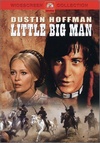 In the movie presented on TVO, “Little Big Man”, Dustin Hoffman stars in the role of the aged Jack Crabb, a wily old coot who claims to tell you what you need to know “about Custer and the way he was and about the Indians and the way they was”. By using this device of sifting the story of the Wild West through the remembered experiences of the ancient Jack Crabb, director Arthur Penn after the novelist Thomas Berger, manages to create a unique point of view on historical events in the American West.
In the movie presented on TVO, “Little Big Man”, Dustin Hoffman stars in the role of the aged Jack Crabb, a wily old coot who claims to tell you what you need to know “about Custer and the way he was and about the Indians and the way they was”. By using this device of sifting the story of the Wild West through the remembered experiences of the ancient Jack Crabb, director Arthur Penn after the novelist Thomas Berger, manages to create a unique point of view on historical events in the American West.
After all, who is going to dispute with the memories and musings of a man who is more than 120 years old? It’s just not something that you do. No. You end up doing what the rather pretentious over-educated historian with his fancy tape recorder does; you just sit down and listen to the ramblings of someone who has lived a very different life. You end up taking in the story just as it spills out of Jack Crabb’s mouth, memories of a very old man who makes no pretence of telling you the whole truth. Jack Crabb only claims to tell you his story as he remembers it, confused and confusing as it is.
The “truth” about matters may be in there somewhere, but this is primarily the story of Jack Crabb. The movie is not about distilling the absolute truth about the way things were in the Wild West. It is about learning something important as you listen to the stories and ruminations of the elders, much as Little Big Man did in those countless encounters with his grandfather, Old Lodge Skins (Chief Dan George).
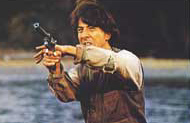 Through this device of telling the tale of an old man’s life remembered, the filmmaker is able to accomplish many things that might not otherwise be possible. A straightforward telling of a revisionist history of the Wild West would hardly have been as palatable. It almost certainly would not have been as memorable. And how else could one manage the excruciating re-examination of questions of conscience concerning the genocide of the American Indians without installing the counterbalance of zany comedy? The comedy, rather than being a mere distraction, somehow allows the mind of the viewer to take in the horrors of the Indian Wars that middle America might otherwise find it convenient to “screen out”.
Through this device of telling the tale of an old man’s life remembered, the filmmaker is able to accomplish many things that might not otherwise be possible. A straightforward telling of a revisionist history of the Wild West would hardly have been as palatable. It almost certainly would not have been as memorable. And how else could one manage the excruciating re-examination of questions of conscience concerning the genocide of the American Indians without installing the counterbalance of zany comedy? The comedy, rather than being a mere distraction, somehow allows the mind of the viewer to take in the horrors of the Indian Wars that middle America might otherwise find it convenient to “screen out”.
The overall effect in my opinion is that the viewer ends up with something that is “truer than the truth”, if that makes any sense. One reviewer that I read made mention of Charles Dickens’ caricatures in his novels. “Little Big Man” does something of the same thing.
Much of what goes on in the film is the presentation in episodic fashion of a series of caricatures. They are portraits painted with sensitivity and liveliness, but caricatures nonetheless. Dickens used these fictitious creations in his popular writings to entice the people of his day (and later students of his works) to examine serious social questions that very much needed examination. Dickens’ initial goals may have been commercial success and the entertainment of the public.
However, in retrospect, one can say that Dickens certainly must have intended what he achieved during his career; influence in the larger arena of social commentary and social activism. The point was that Dickens did not just write to entertain people. There was a part of him that desperately wanted to change the way people looked at things. As a result of changing people’s level of consciousness about certain realities in society, perhaps an author like Dickens hoped that society would one day actually change for the better.
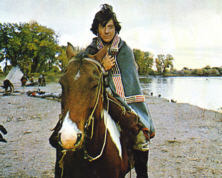 Jack Crabb moves back and forth between the world of the Indian and the white man’s world. He moves from one adventure to another, from one accident of fortune to the next. As he goes, Jack tries on various philosophies of life in much the same way as he changes his outfit to fit his situation. When we leave Jack at the end of the movie, he doesn’t seem to have a handle on things any more than he did at the beginning of the film as a confused 10 year old.
Jack Crabb moves back and forth between the world of the Indian and the white man’s world. He moves from one adventure to another, from one accident of fortune to the next. As he goes, Jack tries on various philosophies of life in much the same way as he changes his outfit to fit his situation. When we leave Jack at the end of the movie, he doesn’t seem to have a handle on things any more than he did at the beginning of the film as a confused 10 year old.
Old Lodge Skins, Jack’s adoptive Indian grandfather, has some wonderful lines near the end of the film. As the elderly Indian gives an eloquent elegy for his own funeral from a spectacular mountain vista, you feel along with Jack that the cycles of life are mysterious and magnificent and that everything on the earth, including mankind, has a place. There is a time to live and a time to die. Old Lodge Skins has said that it was a good day to die. Surely he must know. You fully believe, as the old mystic lies down beside his burial pyre, that Old Lodge Skins is so much in touch with the spiritual realities of life that he can actually decide to die at a given moment. As the rain begins to plop on the grandfather’s closed eyelids, everything does an about face. “Sometimes the magic works, and sometimes it does not,” is all that the unflappable Old Lodge Skins has to say about it as he hobbles down off the mountaintop.
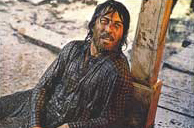 Such events, comical as they may be as a final statement on the life of Jack Crabb seem to support the philosophy of life espoused by the snake oil salesman, Merriweather. The Dustin Hoffman character appears to be battered by life’s meaninglessness, condemned to a fate worse than death. Jack Crabb survives multiple calamities and reversals of fortune without ever being able to quite put it all together.
Such events, comical as they may be as a final statement on the life of Jack Crabb seem to support the philosophy of life espoused by the snake oil salesman, Merriweather. The Dustin Hoffman character appears to be battered by life’s meaninglessness, condemned to a fate worse than death. Jack Crabb survives multiple calamities and reversals of fortune without ever being able to quite put it all together.
Merriweather observes rather wryly about his young protégé, “That old Indian has taught you too well.” But Jack Crabb can neither live nor die as a Cheyenne brave. Neither can he live out his years in the comfort of the white man’s world. He has known too much of the Indian way of life to adapt himself fully to the craziness of the whites who live without knowing where the centre of the world lies. In the end he is an old white man who hasn’t been able to sing a hymn in over a hundred and four years. Now there’s a pity.
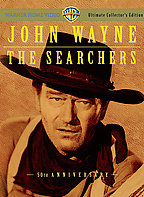 The first feature on Saturday Night at the Movies, “The Searchers” was a classic John Wayne Western. This first film had real entertainment value, although I must admit that I was not looking forward to seeing it again as much as I was looking forward to rewatching “Little Big Man”.
The first feature on Saturday Night at the Movies, “The Searchers” was a classic John Wayne Western. This first film had real entertainment value, although I must admit that I was not looking forward to seeing it again as much as I was looking forward to rewatching “Little Big Man”.
The producers went for a sure-fire combination of the ever popular Western theme, star power in John Wayne, sex appeal with the younger characters of Nathalie Wood and Jeffrey Hunter, and comic relief in Hank Word (as Mose Harper). It seemed to work pretty well.
“The Searchers” does appear to be a bit more complex than many “shoot’em up, hang’em high, rescue the damsel in distress” formula Westerns. It actually does approach some deeper subjects through the classic Western formula. We discover that things are a bit more complex than they at first appear.
John Wayne is a war hero of sorts, but his past is a little more shady and his motives for going on this five year quest are a bit more muddy than we’re used to seeing at the Saturday matinee Western. In fact, when John Wayne finally achieves his goal and comes upon his niece, Debbie, things are so emotionally complex that we are not sure if he is going to shoot her or “rescue” her. Likewise, in traditional Hollywood Westerns, we are not supposed to have any kind of ambiguous feelings about Indians, at least not the kind who raid homesteads and massacre settlers. Things are supposed to be pretty clear-cut and uncomplicated.
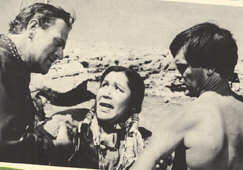 As a latter viewer of the film, my big problem with Cicatrice, the Comanche chief is not that he is potrayed as a real human being, but that he seems to be miscast. Henry Brandon, a capable and hardworking actor of European descent, just did not look or feel to me like a real Indian chief. In your standard Western where you have a whole bunch of guys running around on a back lot dressed up in wigs and grease paint as Indians getting shot at by a whole bunch of other guys dressed up in cowboy suits, it doesn’t really matter so much. But this time, given the rest of the film, I think that it did matter that Cicatrice, the Comanche chief, was just another European dressed up like an Indian.
As a latter viewer of the film, my big problem with Cicatrice, the Comanche chief is not that he is potrayed as a real human being, but that he seems to be miscast. Henry Brandon, a capable and hardworking actor of European descent, just did not look or feel to me like a real Indian chief. In your standard Western where you have a whole bunch of guys running around on a back lot dressed up in wigs and grease paint as Indians getting shot at by a whole bunch of other guys dressed up in cowboy suits, it doesn’t really matter so much. But this time, given the rest of the film, I think that it did matter that Cicatrice, the Comanche chief, was just another European dressed up like an Indian.
One thing where John Ford really did get it right was the ending. John Wayne stands framed in the doorway at the end of the film in an iconic moment. This is a Western with a difference. The film begins and ends with this 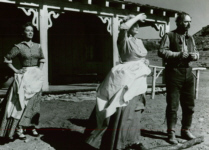 doorway. The lone gunman does not go riding off into the sunset, off to his next heroic adventure. He hesitates in the shadow of a doorway. What is Ethan Edwards supposed to be thinking about at that moment? What was “the fate worse than death” after all? What is Ethan Edward’s place in civilized white society? Are we so civilized after all? Is this man a hero to be admired or an obsessive maniac to be pitied and eschewed?
doorway. The lone gunman does not go riding off into the sunset, off to his next heroic adventure. He hesitates in the shadow of a doorway. What is Ethan Edwards supposed to be thinking about at that moment? What was “the fate worse than death” after all? What is Ethan Edward’s place in civilized white society? Are we so civilized after all? Is this man a hero to be admired or an obsessive maniac to be pitied and eschewed?
Now before we get too deep into all of this social analysis stuff, let’s remember that this is John Wayne and it is a John Ford film in the mid-fifties. And it is, above all, a classic Western. Bring on the popcorn!
Suggested Reading:
- IMDb Trivia: Two additional motives are hinted at for Ethan Edwards unending passion for revenge buried in the film “The Searchers” – watch the graveyard scene.
- How could he do it? Selling out to the “white man’s religion”.
- Another look at the “Big Story”
- Dealing with putting a loved one in a home.
- Communicating positively with aging parents
- A fate worse than death: a personal story of facing up to Lou Gehrig’s disease
- Tough questions: euthanasia from more than a dramatic angle. Includes a look at Eastwood’s “Million Dollar Baby”
Blade Runner (1982) and The Day the Earth Stood Still (1951)
Eternity in Their Hearts
I saw “Blade Runner” for the first time in the past year. The DVD was handed to me by a friend of ours who said it was one of his all-time favourite movies. That friend has been in the hospital this week in serious condition awaiting surgery for a chronic debilitating condition that causes him much pain. He has been living in his own waking nightmare for the last few months, seemingly with no hope of escape. Purportedly, the physical defect that causes him such pain and misery cannot be fixed. When you see someone suffer and perhaps even die from an “incurable” disease at such a young age, something in you cries out and says, “It’s not fair! This is not how it’s supposed to be!”
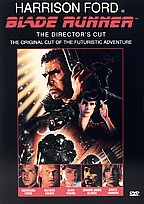 I was very blessed to have only seen the Director’s Cut of the movie “Blade Runner”. The Interviews on TVO gave me some ideas of what the original 1982 version of the film was like with all of its hokie add-ons still intact. After being exposed to the Director’s Cut of the film initially, those add-ons looked like, well, like bad afterthoughts, which they probably were – the monotone Harrison Ford commentary and the sunshiney “happy ending”.
I was very blessed to have only seen the Director’s Cut of the movie “Blade Runner”. The Interviews on TVO gave me some ideas of what the original 1982 version of the film was like with all of its hokie add-ons still intact. After being exposed to the Director’s Cut of the film initially, those add-ons looked like, well, like bad afterthoughts, which they probably were – the monotone Harrison Ford commentary and the sunshiney “happy ending”.
The first time around I had problems really getting into the film. It is so dreary, so dissonant and so disorienting. It is not that easy to follow what is really going on. I tried to walk away from the film several times saying “I have better things to do with my time” only to find that it was really getting under my skin. Like it or not, I had to find out what happened to these strange outerworld characters and their even stranger real world counterparts. (I mean, the replicants have an excuse for being more than a bit off-base because they aren’t even human, but as for the “real” people, well, they are just strange. I guess we can blame it on the effects of too much smog and chronic overcrowding???)
And what happens as the story unfolds is ever stranger. As Deckard goes about his business of eliminating the “skin jobs” as a kind of ultimate cyber bounty hunter, we become more familiar with the “plight” of the replicants. It seemed to me that, at the same time as the action escalates and intensifies as the replicants get knocked off one by one, they also become progressively more sympathetic characters. It is a strange blend of escalating horror  and empathy. I can’t admit to being too emotionally involved when “Leon Kowalski” gets turfed. Zhora’s demise is portrayed a bit more sympathetically, intentionally so, according to Joanna Cassidy during the Intervews. The death of Pris, the ‘pleasure model’, is fully emotionally realized in terms of simultaneous tragedy and horror. Rutger Hauer as Roy brings home a riveting performance in his final minutes as the warrior poet atop a rain-soaked building. Neither we nor the beaten and cowering Deckard quite know what to make of Roy in his final soliloquy. It is so unexpected in every sense of the word.
and empathy. I can’t admit to being too emotionally involved when “Leon Kowalski” gets turfed. Zhora’s demise is portrayed a bit more sympathetically, intentionally so, according to Joanna Cassidy during the Intervews. The death of Pris, the ‘pleasure model’, is fully emotionally realized in terms of simultaneous tragedy and horror. Rutger Hauer as Roy brings home a riveting performance in his final minutes as the warrior poet atop a rain-soaked building. Neither we nor the beaten and cowering Deckard quite know what to make of Roy in his final soliloquy. It is so unexpected in every sense of the word.
 By the time Deckard gets back to the last replicant, Rachael, who is waiting at his apartment, the emotional tension is unbearable. As Deckard slowly draws back the sheet to reveal Rachael’s still form, it matters to us very much whether she is alive or dead. Whether she is, in fact, a machine or fully human as she so desperately wants to believe herself to be, we want her to live. Deckard’s emotions and will and ours reshape reality.
By the time Deckard gets back to the last replicant, Rachael, who is waiting at his apartment, the emotional tension is unbearable. As Deckard slowly draws back the sheet to reveal Rachael’s still form, it matters to us very much whether she is alive or dead. Whether she is, in fact, a machine or fully human as she so desperately wants to believe herself to be, we want her to live. Deckard’s emotions and will and ours reshape reality.
The ambiguity created by Ridley Scott for me serves to bring out rather than bury certain important themes in the film such as the essence of being human, the quest for immortality, the fundamental human need for love and meaning, the ephemeral nature of memory, and freedom as an ‘inalienable’ human right. The postmodern fascination with eternal ambiguities and redefinitions of truth and reality makes this a difficult film to view for some, but it also renders the film more interesting on a second, third, and fourth viewing. Perhaps it is this postmodern sensibility that made the film inaccessible for the popular audience when it was first brought to the screen in 1982. However, this same “sensibility” accounts for its increasing reputation and cult following as the years have passed. More people are more comfortable with the vision of the world that Ridley conveys in this film because it has more in common with the ways in which the majority now experience life. It was a film that was “before its time”.
I am glad that I missed the film in 1982. I wouldn’t have been ready for it. The queer mixture of cyberpunk and 1940’s film noir would have been too jarring a juxtaposition for me. With distance and a bit more maturity, I can see where the film has something to say as well as an artful manner of saying it. I can’t really say that I “liked” the film, but I can admit to appreciating it in that uncomfortable “get under your skin” kind of way.
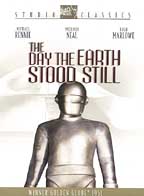 My kids liked the first flick, “The Day the Earth Stood Still”. My son told me very proudly the next day that he had not had a nightmare as a result of watching the movie. I think that maybe he has watched that “George Shrinks” episode (or maybe it was “Miss B.G.”) one too many times where George gets himself into trouble after too much pizza and altogether too silly scary sci-fi movies.
My kids liked the first flick, “The Day the Earth Stood Still”. My son told me very proudly the next day that he had not had a nightmare as a result of watching the movie. I think that maybe he has watched that “George Shrinks” episode (or maybe it was “Miss B.G.”) one too many times where George gets himself into trouble after too much pizza and altogether too silly scary sci-fi movies.
My kids didn’t mind the low-tech special effects (a man in a rubber suit for a robot and a rollout runway from the flying saucer). Now I know that the available technology and the budget were somewhat more limited for this film when compared with something like “Blade Runner”, but really! Fortunately for this film, things are much easier on the make-up department than they could have been since much of the action has the main character, the alien Klaatu, running around Washington dressed as a normal circa 1950 human being.
The film has more to say about the atmosphere in post-war America than about any atmospheric conditions on a faraway planet. The United Nations is depicted as an ineffectual agency for maintaining global peace and world order in spite of the pressing need to pursue such a goal. Things haven’t changed much on earth in half a century. One cold war and many regional wars later, world peace is just as elusive as it was in 1950. The U.N. seems just as ineffective today as it was then. Communications and technology may have advanced by leaps and bounds over the intervening decades, but it appears that we are stuck with the same essential problems as human beings when it comes to getting along with each other.
“Get it together and stop the fighting!” says Klaatu in ominous tones, “Or else you will be vaporized as a planet endangering the universal peace and equilibrium.” And Klaatu has a scary robot to back up his warnings.
Sometimes as a parent with constantly squabbling offspring underfoot, I wish I could pull out a big scary robot with laser beams hidden under his visor as a deterrent. Threats of vaporization might work nicely in order to maintain household peace and stability. But then again, maybe not. It might work for a while, but then the kids would find out that it was just an ordinary guy in a rubber suit or that they were not really going to be terminated immediately. If only it were so easy to get them to change their behaviour! No, I guess I will have to wait for a better approach. In the meantime, since I am not really willing to vaporize my offspring, I guess I have to put up with an awful lot of squabbling.
On May 27th on SNATM at 8pm EST on TVOntario, catch John Wayne doing his cowboy thing in “The Searchers” followed by Dustin Hoffman as “Little Big Man”.
Suggested Reading:
- No camera tricks here! Gort the robot really was that tall in “The Day the Earth Stood Still”. See IMDb
- Eternity in their hearts: Context please.
- Can people really change? “I wanted to be one of the freest people in the whole world,” Josh McDowell’s seldom heard story.
- Peace in war-torn Rwanda: a personal journey
- The Day of Reckoning: “My friend drew one unforgettable word on the computer screen – Die.”
- So what’s the point? Life after life
blade+runnerthe+day+the+earth+stood+ still
Dirty Rotten Scoundrels (1988) and The Grifters (1990)
Steve Martin and Michael Cain are fun and frothy in this comic look at the con game (Dirty Rotten Scoundrels). The Huston/Cusack/Bening trio in The Grifters tells us something quite different about the seamier side of the life of a con artist. It's not all fun and games.
Who's Conning Who?
Saturday Night at the Movies on TVO drifted into Mother’s Day at about midnight . Mother’s Day was a very traditional affair at our house on Sunday: lunch at a restaurant, grandma visiting, homemade cards, childish hands clutching little bunches of spring flowers, special presents for Mom – in short, all the obligatory stuff that warms a mother’s heart. My little seven year old boy came over to me several times in the day and spontaneously gave me a hug. He looked up at me with those trusting, innocent eyes and said things like, “I love you mommy” and “You look pretty in those clothes mommy.” Precious treasures, memories like that. And the thing is that they really are just a part of my everyday “normal” life. Gushy and maudlin, well maybe – but that’s my life.
 There’s a slight disconnect there between my “real” life and the film I was watching on TVO on Saturday night just minutes before we slipped into Mother’s Day. “The Grifters”, directed by Stephen Frears, was announced as a gritty version of the life of a con artist. Man, that was so gritty I can still feel the sand in my mouth! Grimy might be another apt adjective. Why am I not surprised with Martin Scorsese listed in the credits as a producer? Scorsese’s name on the picture however, gave me an indication that, while it would not be pretty, it would probably be a good film.
There’s a slight disconnect there between my “real” life and the film I was watching on TVO on Saturday night just minutes before we slipped into Mother’s Day. “The Grifters”, directed by Stephen Frears, was announced as a gritty version of the life of a con artist. Man, that was so gritty I can still feel the sand in my mouth! Grimy might be another apt adjective. Why am I not surprised with Martin Scorsese listed in the credits as a producer? Scorsese’s name on the picture however, gave me an indication that, while it would not be pretty, it would probably be a good film.
I think back to the penultimate scene where Lilly has come to Roy ’s apartment to take his money and make a run for it. Lilly’s relationship with her son, Roy, is complicated and conflicted, to say the least. At one point, in order to calm herself down and buy more time, Lilly walks into the kitchen to get herself some ice water. She hands the water to Roy and says, “Go ahead. You can’t tell whether it’s poisoned or not, can you?” Roy doesn’t know whether the water is poisoned or not, but he does know that he can’t trust his mother. It’s a kind of an “anti-Mother’s Day” testimonial; everything that a mother and Mother’s Day are not supposed to be.
After having watched the rest of the movie, nothing about the behaviour of the mother and son duo during this scene was surprising - shocking maybe, but surprising, no. The only surprise was the gruesome accident with the broken glass. This came as a surprise to Lilly herself. Lilly weeps over the body of her son with genuine tears of shock and remorse. It is not that Lilly is not human. She is just fully given over to corruption. She scoops up the bloodied bills that lay scattered on the floor and stuffs them into the briefcase.
Mother instinct is overcome quickly enough by survival instinct. In the final scene, Lilly’s face is pictured as hardened and emotionless against the darkness of the night cityscape as she carefully turns the car into the roadway so that she can drive off to the next grift.
Wow! Now that’s sleaze in its full, unabridged form.
Roy , Myra and Lilly are all trapped in a destructive lifestyle from which there is no apparent escape other than through the unsavoury exit door of death. Roy maintains that he can walk away from the lifestyle anytime he wants. He claims that he is going to play it straight. While Myra attempts to lure Roy into the long con and Lilly and her lifestyle propel him into the short con, Roy attempts to assert his independence from both of them. Before we find out whether Roy really will carry through on his intentions, death catches up with him. Somehow, given what we know about Roy and about the lifestyle of the con artist, we have doubts as to whether he actually would succeed in getting out in time from under the weight of his chosen profession. Roy sounds a bit too much like an addict to me.
Under the thin veneer of “cool” self-control and reckless abandon to the pursuit of pleasure, there lurk other emotions that are more troubling to observe. All three of the grifters in this film seem to accidentally betray deep self-loathing, vicious anger, and, at times a sense of despair. One thinks of Myra ’s strangely out of place giggles as she “pays the rent” and Lilly’s stark terror in facing Bobo with his grocery bag of oranges. The grift and all of the concentration that it requires actually appears to take their mind off of these inner problems, at least for a while. The worst thing about it is that there is no refuge either from the inner angst or the outward consequences of the lifestyle. At one point Lilly says to Roy, “I thought maybe we could be straight with each other for once,” but nothing could be further from the truth. The one inviolable law of the world of the con is that you can’t trust anyone. Ever.
The first film of the evening, “Dirty Rotten Scoundrels” also shows us the same message about the con artist but from a completely different angle. As much as “The Grifters” is dark and deadly in its tone, “Dirty Rotten Scoundrels” remains effervescent and fun. Frank Oz directs this tale of the highly amusing antics of two cons playing their tricks on the unsuspecting clientele of the French Riviera.
Two more likeable cons than Lawrence Jamieson, played by Michael Cain, and Freddy Benson as brought to us by  Steve Martin would be hard to find. Not that I generally like Steve Martin movies. Even though I thoroughly enjoyed this romp through the Riviera courtesy of Messieurs Martin and Cain, I fail to be persuaded that I like Steve Martin as an actor. Yes, Martin does that physical sort of humour stuff pretty well, but it really isn’t my style. I think that the inimitable Michael Cain as supported by the obviously versatile Ms. Glenne Headly carried the day for me. They made Steve Martin just barely bearable.
Steve Martin would be hard to find. Not that I generally like Steve Martin movies. Even though I thoroughly enjoyed this romp through the Riviera courtesy of Messieurs Martin and Cain, I fail to be persuaded that I like Steve Martin as an actor. Yes, Martin does that physical sort of humour stuff pretty well, but it really isn’t my style. I think that the inimitable Michael Cain as supported by the obviously versatile Ms. Glenne Headly carried the day for me. They made Steve Martin just barely bearable.
The swindlers get swindled in the end, nobody really gets hurt, and the marks all deserved to lose all that lovely money anyways. What great fun to watch the plot unfold and see the plotters undone!
It was a nicely paired set of movies, although perhaps I would have done well to go to bed early while things stayed on the “frothy” side as I think Johanne Schneller put it. It might have left me in a more positive frame of mind for Mother’s Day.
Next week we have another interesting pair of films starting at 8pm EST on TVOntario. Prepare to be dazzled by the early 1951 sci-fi flick “The Day the Earth Stood Still” with Patricia Neil and Michael Rennie followed by the cult classic from 1982, “Blade Runner” with Harrison Ford and Rutger Hauer. Then, just for kicks, stick around for the late late show with “Planet of the Apes” starring Charleton Heston in one of his big non-biblical roles.
Suggested Reading :
- Are the TVO producers being very clever or what? Is this like one of those multi-mirrored secret passageway entrances. John Cusack from “The Grifters” also stars with “Dangerous Liaison” star, John Malkovitch, in the quirky comedy “Being John Malkovitch” (IMDb)
- A model’s life; glamour, fast living and escape from a destructive alcohol addiction
- Escape from a dangerous place: one mother’s story
- What to do with someone who drips garbage into your life
Kramer vs. Kramer (1979)
Real Life, Real Divorce, Really Hard
My friend is going through a rough time in her marriage. I don’t know if the marriage will survive. It’s not easy for the kids.
Truth be told, I have a few different friends and acquaintances who are going through really difficult things in their marriages. The “issues” that these people are dealing with seem a tad more serious than the “issues” presented in Kramer vs. Kramer on TVO’s Saturday Night at the Movies this past Saturday: chronic debilitating physical illness, mental illness, pornography addiction, financial instability, a severely disabled child. The list goes on. As mentioned in a previous entry, one of my friends whose marriage ended in divorce was in so much emotional pain that she eventually committed suicide.
Man, it’s serious stuff.
 Not to say that Kramer vs. Kramer is a lightweight treatment of the subject of the divorce and its aftermath. That is hardly the case. I found that this portrait of modern day divorce by Robert Benton was delicately drawn, much like Vivaldi mandolin concerto that plays in the background.
Not to say that Kramer vs. Kramer is a lightweight treatment of the subject of the divorce and its aftermath. That is hardly the case. I found that this portrait of modern day divorce by Robert Benton was delicately drawn, much like Vivaldi mandolin concerto that plays in the background.
The characters are complex, and, I found, strikingly true to life. Dustin Hoffman as Ted Kramer, the workaholic New York ad man, is entirely believable. As many others have said, the interactions between Hoffman and the young Justin Henry were remarkably realistic as father and son grope their way towards working out a new way of relating to each other after mom leaves. Meryl Streep as Joanna Kramer also plays a very persuasive part as a supporting actress. Persuasive is a funny word to use here since Streep’s character fails to be “persuasive” at the climax of the film during the court custody battle. We are not at all persuaded that the judge has made a just decision in awarding custody to the mother. However, the whole import of the film, including Meryl Streep’s performance, manages to persuade us emotionally that both sides in the marital conflict have their faults and their fine points. Just as in real life, it is tricky business to decide who needs to take responsibility for what and what really would be best.
At one point in the movie, Ted really loses it when the kid accidentally spills his juice on the living room coffee  table and ruins the papers he has been working on for an important deadline. Ted responds “inappropriately”. He is very angry as the pressure of adult responsibilities from his work life and the outcome of normal childish behaviour from his life as a parent collide. Who of us, myself included, cannot find themselves in Ted’s momentary outburst of anger? It’s real life as a real parent. This does not mean that Ted is a “bad” father. It also doesn’t mean that his actions and attitudes are okay. It just means that he is human.
table and ruins the papers he has been working on for an important deadline. Ted responds “inappropriately”. He is very angry as the pressure of adult responsibilities from his work life and the outcome of normal childish behaviour from his life as a parent collide. Who of us, myself included, cannot find themselves in Ted’s momentary outburst of anger? It’s real life as a real parent. This does not mean that Ted is a “bad” father. It also doesn’t mean that his actions and attitudes are okay. It just means that he is human.
A short time later in the film, Ted does respond appropriately to Billy as he reads a letter from his wife to the little boy. The letter uses Joanna’s words to try to explain to her son why she felt it necessary to leave. She writes, “It just means that I won’t be your mommy in the house but I’ll always be your mommy in the heart.” Billy doesn’t buy it. He rolls over in bed and flicks on the T.V. Billy feels hurt and rejected because his mommy has left,  no matter what anyone says about it. Ted tries to “explain” things to his son in a way that perhaps he can understand. Ted’s explanationdemonstrates a great deal of personal growth and maturing when one thinks back to his state of relative emotional immaturity and self-absorption at the beginning of the film. Ted is trying his best to be a good parent. But sometimes, in such circumstances, one’s best is just not enough. Billy will survive the divorce ordeal much better because his dad has learned to grow up a bit. It still doesn’t change the reality: Billy’s little world has been blasted to pieces by his parents’ marital conflict.
no matter what anyone says about it. Ted tries to “explain” things to his son in a way that perhaps he can understand. Ted’s explanationdemonstrates a great deal of personal growth and maturing when one thinks back to his state of relative emotional immaturity and self-absorption at the beginning of the film. Ted is trying his best to be a good parent. But sometimes, in such circumstances, one’s best is just not enough. Billy will survive the divorce ordeal much better because his dad has learned to grow up a bit. It still doesn’t change the reality: Billy’s little world has been blasted to pieces by his parents’ marital conflict.
The film ends on a somewhat positive note. You feel as if there is hope, if not for the marriage itself, then at least for the potential for growth in human relationships. Ted’s last words to his ex-wife as she ascends in the elevator with a tear-stained face are, “You look terrific.” Ted is not being trite or flippant. Whereas he might have said the same thing at the beginning of the film in a way that refused to acknowledge Joanna’s personhood, this time around you feel like Ted has actually learned something about what it means to be accepting and supportive of another human being. That’s an accomplishment. One might do well in the general course of things to learn this lesson before one embarks on the difficult and dangerous voyage of marriage and raising kids, but, what with one thing and another, it is understandable how some of us come to it later than others. It seems to be the message of the film to say something like, “Better late than never”.
When I first saw this film many years ago I was thoroughly impressed. I said to myself, “That is a good movie.” Today, more than 25 years later, I have watched a lot more films. I still have the same conclusion, “Now that was a good movie.”
See what TVOntario is up to next Saturday night, May 13th starting at 8pm EST with “Dirty Rotten Scoundrels” (1988) with Michael Cain and Steve Martin and “The Grifters” with Anjelica Huston and John Cusack to be followed by “Dangerous Liasons” for the late show. Let’s hear it for the seedy side of human nature!
Suggested Reading:
- Ebert reports that the realism between Hoffman and Henry was due to on-set improvisation
- First person account: hope for a failing marriage
- For the first-timer: in view of the risks of divorce, why should we even try this marriage thing?
- Helping kids deal with divorce
- Leaving an emotionally abusive relationship
Giant (1956) and September 30, 1955 (1977)
Where ya headed, Jimmy Dean?
On the 50th anniversary of actor James Dean's death in a fatal car crash, TVO presented two films. The first," Giant" casts Jimmy Dean in a starring role. The second film, "September 30th, 1955" is a movie about the impact of the death of the film icon on a group of young adults.

"So, you wanna be my cowboy?" Liz Taylor and Rock Hudson in "Giant"
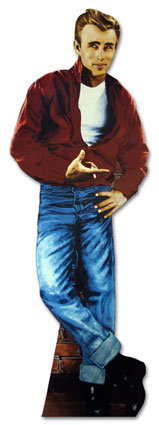
The famous red jacket from "Rebel without a Cause". Richard Thomas takes on his idol's identity at the end of "September 30, 1955", wearing a red jacket and white t-shirt and riding off into the sunset on his new motorcycle.
James Dean, an icon of youth and rebellion




